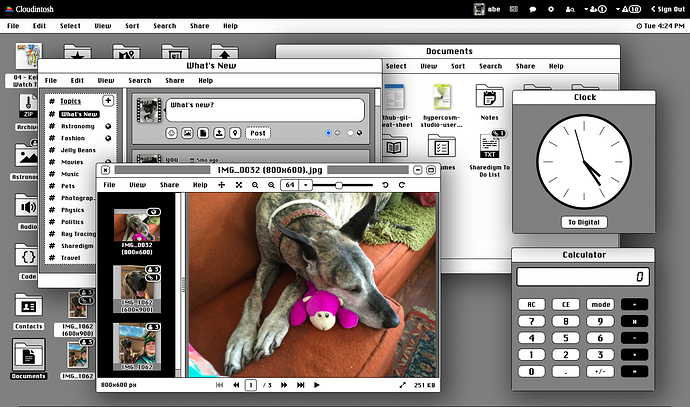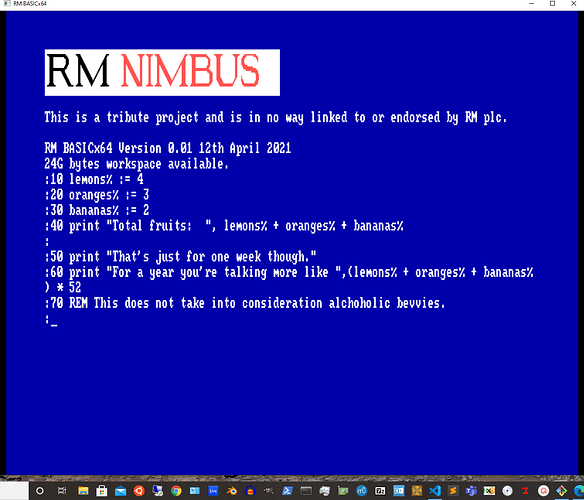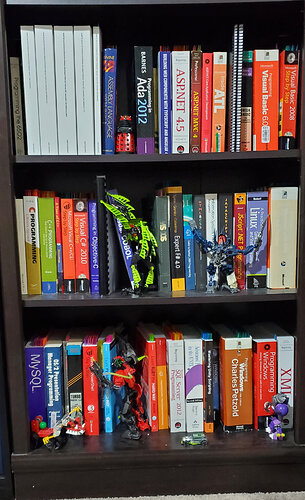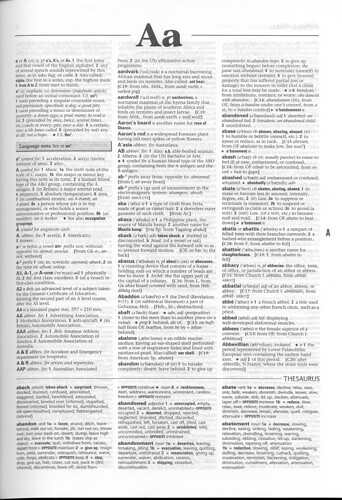Welcome, @Kerri_Shotts and welcome @DavidG too. An introduction post is much appreciated.
Hi. Like many of you, I was introduced to computing with an Apple IIe. A close friend had an Amiga 500, a Sinclair QL, and even a Vectrex! I have a soft spot for ThinkPascal on the Mac.
I think the thing about retro computing that I find interesting is that I’m interested in design that is timeless. Hindsight gives us the ability to more accurately gauge which things really add value on a human level and which things were artifacts or hype driven but not really all that useful. I find a lot of computing today is driven by hype and poor design and some days I long for the consistency, discoverability and simplicity of some of the best systems from other eras (hooray for the Mac style guides and boo to today’s hamburger menus and overly flat design).
For the past few years, I’ve been working on and using a cloud based OS and have recently launched a couple of vintage themed variations based upon it:
www.cloudretrocomputing.com
www.cloudintosh.com
-abe.
Welcome @amegahed and thanks for your introduction! (Welcome also to other recent joiners - please feel free to share a little about your retro journey.)
We’ve had about 40 new joiners since that last introduction, which is great - anyone like to speak up, about how they discovered this forum, how they came to computers, what their current retrocomputing interests are?
Hi folks! I’m a Python developer working on web services and machine learning, and also learning Go.
Got into computing aged 6 when we got a CPC464 and shortly afterwards my dad, who was a teacher, brought an RM Nimbus home every weekend for us to play with.
At the moment I’m doing something very silly: Re-implementing RM Basic as a 64-bit application that can run on Windows and Linux. There’s loads of people working on old interpreters but RM Basic seems totally dead and forgotten - I just felt sorry for it!
Tried running RM Basic on the MAME64 Nimbus but realised there was no way I could decompile and recompile it to add new features. So RM BASICx64 is like a self-contained emulator and BASIC interpreter in one. At the moment it can save programs, evaluate expressions, PRINT, GOTO and one or two other things. Next on the list are arrays, functions, subroutines, etc. Here’s a screenshot:
Please please please hit me up if you have any interest or background in RM Basic. All I’ve found so far are the manuals and, by decompiling the original executable, a shout-out to “Tim, Goat, Gerry & Co.” ![]()
Github link: GitHub - adamstimb/rmbasicx64: A backwards-compatible RM Basic interpreter for Windows and Linux
Looking forward to getting to know you all - already seen some really interesting projects going on!
Cheers.
-Tim
Thank you - much appreciated! 
Hello, my name is Kyle and I am a software developer.
My interaction with computers starts in the mid 90’s. The first computer I really remember was an AST machine running windows 95. I also remember using an IBM or IBM clone we got from my uncle but I’m not sure if that was before or after the AST machine. I used computers quite often at school and home. My first interaction with hardware was when my computer stopped working so I took it apart to see if I could tell why. I didn’t really know what I was doing then so we ended up taking it in to get repaired. My first sort of interaction with software was when I started doing some hex-editing for Half-Life 2/G-Mod model makers. The Valve model format had the path to the texture files written into it so if you wanted to have a separate model instead of just a replacement model you had to edit the data in the model file to change the path names. The trick being that you couldn’t add or remove characters, so the new path had to be the same length as the original. I also played with some 3D modeling at that time.
It wasn’t till university when my interest in computers really took off. I had to take a programming course as part of my first year and it just clicked. I built my first computer that summer and, apart from not understanding what thermal grease did, everything went well. I then majored in computers and have been working as a software developer ever since.
Through university and my later working career my interest in programming languages grew, especially older programming languages. I’m fascinated by the history of them and learning why things were did a certain way and how that influenced the things that came after. I own way too many programming books and I’ve been trying to work my way through them and learn as much as I can.
My interest in retro computing sort of comes out of that. I used an MS-DOS virtual machine to run Turbo Pascal and MASM and lately I’ve wanted to go even earlier. Recently I bought an old Pentium III based Dell, similar to one I had as a kid, and I’m using it to run Windows 3.1, OS/2 2.2, Windows 98 SE, and Windows NT 4.0. I’ve also recently bought an Altair 8800 Clone and a The C64. I’ve been using the 8800 clone to learn about 8080 instructions and plan to use it to learn about early versions of BASIC and CP/M. I want to do something similar with The C64 and 65XX instructions and Commodore BASIC. I’d also like to get a Spectrum Next if they come up for sale again and maybe an FPGA board.
I’m kind of trying to stay away from real retro hardware at the moment because I haven’t done a lot of soldering and I don’t really feel confident troubleshooting hardware. I’m working on a kit to build a 6502 based computer on a breadboard and after I’m done that I’ll probably try some soldering and then maybe look into getting some real retro machines.
Well, I’m not sure how coherent that is but hopefully it works as an introduction.
Great intro - welcome! I like the way you are working backwards beyond the point where you came in.
Welcome Kyle! Is that Ben Eater’s breadboard 6502 you’re building? It sounds like your retro-journey is similar to mine, except you’re further along it than I am.
Yeah that’s the one. I’ve only done the first part of the clock circuit so far though. Been focusing on the 8800 clone lately.
Hi,
I am Dré Jansen, retired maintenance technician.
I live in the Netherlands in a village close to Rotterdam.
Hobbies building robots, 3D drawing and printing.
Welcome! And thanks for the introduction.
The first computer that I worked with was a Zilog MCZ 1/20 microcomputer with a 2MHz Z80 and 64Kb RAM. A pretty sophisticated machine at the time.
I began university studying Computational Science (sort of computer studies with maths) in 1978 at the University of Hull in the UK. We learnt to program in Pascal using punched cards and a batch system on an ICL 1904S mainframe. A year later we were allowed to use out departmental minicomputer - a PR1ME 300 running Primos using CRT terminals. The 300 dies during a fire and was replaced with a PR1ME 450.
I left university to work for Plessey Telecommunications on Edge Lane, Liverpool working on the System X telephone exchanges. I lasted about 3 months before the family business called me home. We used micro and minicomputers to typeset large educational texts such as dictionaries, encyclopaedias and directories.
We started to use Xenix, then Unix and finally Linux to batch paginate these texts using the program troff with some local modifications. Our programs were used to typeset dictionaries for Collins, HarperCollins, Cassell, Macmillan, Bonnier and a host of other large publishers.
Out company fell victim to the price-cutting war between the UK printing and publishing industry and the Indial and Chinese manufacturers. I’m sorry to sat thay price won over style and craftsmanship and our company became unsustainable.
I now work for the NHS - I love my job but miss the excitement and ground breaking nature of those early days of my career.
Welcome! I’m sure I speak for many of us when I say I’d love to hear more about early mini- and microcomputer typesetting in a professional environment!
Hiya Les — one of your very happy former clients here. I was one of the computer guys at Collins dictionaries, up until 2002 when I moved to Canada. We kind of knew you used troff, but assumed your shop ran almost entirely on magic. I mean, the way you set the combined Dictionary & Thesaurus was gobsmackingly clever.
(For those who don’t quite nerd out to computer typesetting as we might: a page of the Collins D&T looks like this:
It synchronizes dictionary entries above the line with thesaurus entries below the line. Sure, it’s a very special case of footnotes (perhaps; only Les knows), but keeping this in sync is no trivial task.)
Cost management in print publishing in the early 2000s made no sense, and the margins were squeezed in all the wrong places. For a small dictionary intended for the market in India, it was cheaper for HarperCollins (near Glasgow, Scotland) to:
- Buy paper from Finland and ship it to Scotland;
- Ship paper from Scotland to India;
- Have the books printed and bound in India;
- Ship the books back to Scotland;
- When orders came in, ship the books from Scotland to India as needed
than to either have the whole process carried out in India, or use the printing plant literally next door to HarperCollins’ building.
cheers,
Stewart
Well hi Stewart - it’s been a long time! Hope you’re doing well and enjoying life in Canada.
We did make some beautiful books, didn’t we? I loved the challenges presented by yourselves at HarperCollins and all of the other publishing teams that we worked with.
The dictionary and thesaurus projects were a particular joy. If you are interested, here’s how the magic happened…
The data arrived as two files - the dictionary text and the thesaurus text. We extracted the headword lists for these and sorted the two files into alphabetic order, so that the dictionary headword was followed immediately by the thesaurus headword (if there was one - not all dictionary headwords had a corresponding thesaurus headword).
After reconstituting the data into one file the text was processes. Dictionary headwords went into one typesetting stream (diversion in troff parlance) and the thesaurus headwords went into the other. The remaining white space on the page was monitored and if either a dictionary entry or thesaurus entry exceeded the available space, it was split and the overflow moved to the next page. The page was then output, dictionary text first and split into columns, followed by the designed text that separated the dictionary entries from the thesaurus entries and then the thesaurus text split into columns. Finally, the page livery was output, including running heads, folios and any running foot text. The process started again for the next page, until the entire text was output.
Initially, when our typesetting system was running on Intel 80486 computers, we started a pagination run as we left the office on an evening, to find paginated text waiting for us the next morning (providing nothing went wrong overnight). As technology evolved and processors became faster, we could paginate in real-time. A 500 page book would take about ten minutes to half an hour. The last time I used our typesetting system (in 2010 approximately) it would paginate a 1000 page text in less than a minute. On today’s hardware, I reckon it would be virtually instantaneous.
And therein lay our problems - we made what we did look too easy and it was hard to justify (no pun intended!) the amount that we charged - which wasn’t a vast amount - with what we provided to the customer, which was usually a CD-ROM of PDF pages ready for the Computer-To-Plate process done by the printer. It came down to perceived value – a CD-ROM didn’t look as expensive or work-intensive as a stack of film, bromide or paper. We couldn’t actually reflect how much investment in equipment and resources we had made. For example, our first typesetter cost twice as much as my first house – you would be looking at around £400,000 in today’s money. Our first 28Mb (Megabyte!!) hard drive cost £20,000 second hand.
Still, happy days and exciting times. Everything needed to be invented and I learned a lot about software and hardware and how to bring them together, how to build systems that people could use and how to optimise processes to reduce cost and increase profitability.
Hey!
My name is Alistair, I’ve been playing with retro kit since before it was retro. I have love for lots of 8-bit machines, such as the BBC Micro, Apple II and Atari 800 and many other classics, to 16 bit like the first IBM PC. My life has been peppered with UNIX, so I’m also a big fan of anything Linux/UNIX. I run a channel over on YouTube called Al’s Geek Lab ( https://www.youtube.com/alsgeeklab ) where I cover mostly retro stuff, but also occasionally open source and infosec stuff too.
I also have a keen interest on Bulliten Board Systems, and even decided to start up my own one recently (bbs.alsgeeklab.com:2323). Most of my work these days goes into getting old computers to do stuff they were never designed to do, such as go online. I like to push them to the absolute limits of what is possible, whilst still keeping true to their original machines as possible. Plenty of examples of that on my YouTube videos. So you’ll probably find me here helping out with DOS era stuff mainly, as well as asking questions about things like multi-tasking in DOS, or how to get Arachne web browser to work well… ![]()
Welcome, and thanks for joining us!
Hi, I am Neal. My introduction to electronics was taking apart defunct valve radios to scavenge components (usually tuning capacitors and speakers). I built a Sinclair Micromatic radio (and it worked). Fast forward to my early teenage years and, after many months of saving from a weekend job with Dad, I bought, built and debugged a NASCOM 2, which I later expanded with memory and disks. My final year project at university included the then recently-announced CMOS 6502. All of my working life has been spend in various electronics jobs, including about 10 years working for DEC (involved in wide-area networking, then Alpha processors and finally StrongARM). I am currently employed as a chip designer, designing CMOS image sensors (aka cameras).
Grant Searle’s “multicomp” design kindled my interest in retrocomputing. I built the 6809 version of his design, then expanded and evolved it in various ways and ported all sorts of old software (FLEX, CamelForth, NitrOS-9) and new software (Fuzix) to it.
A leaking water tank in my parents’ house a few years ago prompted me to finally reclaim my NASCOM from my childhood bedroom and bring it back to life. Since then, I have been distracted with various expansion projects for that machine: a virtual tape expansion and virtual disk expansion called “nascom_sdcard” and, most recently, a single-board homage called “NASCOM 4” which is half FPGA and half 74-series logic.
All of my projects can be found on github and, like many others here, I’m also a member of various other retro groups.



